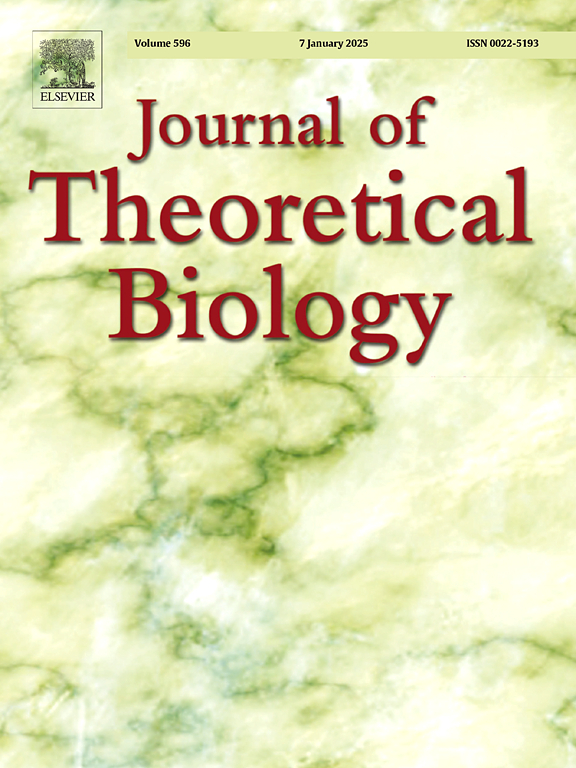细胞内isg -病毒相互作用决定病毒感染的严重程度和持久性。
IF 2
4区 数学
Q2 BIOLOGY
引用次数: 0
摘要
在先天免疫应答中,I型干扰素(ifn)激活干扰素刺激基因(ISGs),从而在细胞内水平抑制病毒的复制和分泌。然而,这些isg病毒相互作用如何影响感染进展和严重程度仍然知之甚少。在这里,我们引入了一个新的病毒感染模型,明确纳入细胞内isg病毒动力学。它首次基于病毒载量和ISG表达构建受感染细胞,这为将ISG病毒细胞内动力学整合到病毒动力学框架中提供了一种计算效率高且适应性强的方法。我们使用前α - COVID-19毒株和HIV的患者数据验证了这种新方法,然后我们用它来研究isg病毒动力学对病毒感染严重程度和持久性的影响。我们的模拟显示,ISG诱导的增加通过抑制感染细胞中I型IFN的产生和防止健康细胞耗竭来延长感染。我们进一步表明有效的isg介导的病毒抑制对控制感染严重程度至关重要。最后,该模型预测适度的病毒分泌可以优化病毒载量的产生。总的来说,开发的框架为探索细胞内I型干扰素信号传导对病毒感染的影响提供了一个灵活且计算效率高的工具。它可以很容易地适应于特定疾病,并与药代动力学-药效学模型扩展,以确定药物开发的关键治疗靶点。本文章由计算机程序翻译,如有差异,请以英文原文为准。
Intracellular ISG-virus interactions determine viral infection severity and persistence
In innate immune response, type I interferons (IFNs) activate interferon-stimulated genes (ISGs), which suppress viral replication and secretion at the intracellular level. Yet, how these ISG-virus interactions shape infection progression and severity remains poorly understood. Here, we introduce a new viral infection model that explicitly incorporates intracellular ISG-virus dynamics. It structures, for the first time, infected cells based on viral load and ISG expression which offers a computationally efficient and adaptable approach to integrating ISG-virus intracellular dynamics into viral kinetics frameworks. We validate this new approach using patient data for pre-alpha COVID-19 strain and an HIV, then we use it to study the impact of ISG-virus kinetics on viral infection severity and persistence. Our simulations reveal that increased ISG induction prolongs infection by suppressing type I IFN production in infected cells and preventing tissue cell depletion. We further show that effective ISG-mediated viral suppression is critical for controlling infection severity. Finally, the model predicts that moderate viral secretion optimizes viral load production. Overall, the developed framework offers a flexible and computationally efficient tool for exploring the impact of intracellular type I interferon signaling on viral infections. It can be easily adapted to specific diseases and extended with pharmacokinetics-pharmacodynamics models to identify key therapeutic targets for drug development.
求助全文
通过发布文献求助,成功后即可免费获取论文全文。
去求助
来源期刊
CiteScore
4.20
自引率
5.00%
发文量
218
审稿时长
51 days
期刊介绍:
The Journal of Theoretical Biology is the leading forum for theoretical perspectives that give insight into biological processes. It covers a very wide range of topics and is of interest to biologists in many areas of research, including:
• Brain and Neuroscience
• Cancer Growth and Treatment
• Cell Biology
• Developmental Biology
• Ecology
• Evolution
• Immunology,
• Infectious and non-infectious Diseases,
• Mathematical, Computational, Biophysical and Statistical Modeling
• Microbiology, Molecular Biology, and Biochemistry
• Networks and Complex Systems
• Physiology
• Pharmacodynamics
• Animal Behavior and Game Theory
Acceptable papers are those that bear significant importance on the biology per se being presented, and not on the mathematical analysis. Papers that include some data or experimental material bearing on theory will be considered, including those that contain comparative study, statistical data analysis, mathematical proof, computer simulations, experiments, field observations, or even philosophical arguments, which are all methods to support or reject theoretical ideas. However, there should be a concerted effort to make papers intelligible to biologists in the chosen field.

 求助内容:
求助内容: 应助结果提醒方式:
应助结果提醒方式:


